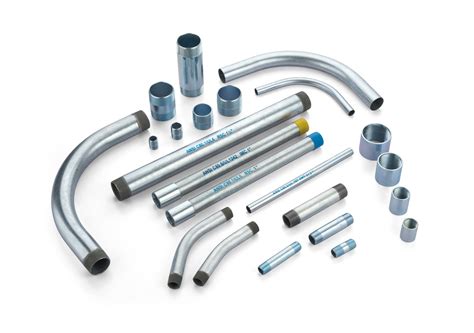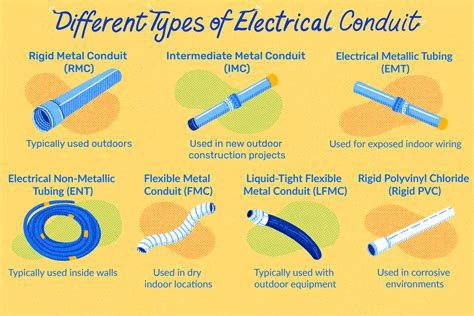can metallic conduit be used in a house Learn if exposed wire is allowed, its dangers, and workarounds like THHN wire for exposed sheathed cables in your home. The National Electrical Code, the basis for all local building codes, has specific regulations for . So I reviewed the process of doing a 2 switch gang box with one power source and drew a diagram for wiring in a plastic box.This page contains wiring diagrams for household light switches and includes: a switch loop, single-pole switches, light dimmer, and a few choices for wiring a outlet switch combo device.
0 · rigid metal electrical conduits
1 · metallic electrical conduit types
2 · metallic electrical conduit installation
3 · how to ground electrical conduit
4 · electrical conduit for walls
5 · electrical conduit
6 · conduit for electrical wiring
7 · conduit for electrical boxes
No electrician needed. Wire your trailer lights with our 7-way diagrams and walkthrough, or watch our how-to video. Perfect for beginners and DIY enthusiasts!
Conduit used for residential wiring includes several types of metal and plastic materials designed for different applications. Here are the most common types: Electrical Metallic Conduit (EMT): Electrical metallic conduit is .
This article series describes both metallic electrical conduit and plastic or non-metallic electrical conduit products, and answers basic questions about installing electrical conduit. Electrical . Heavy-duty rigid metallic conduit, such as galvanized rigid steel conduit (GRC), is not commonly used in residential infrastructure; intermediate metal conduit (IMC) has replaced . Among the types of conduits on the market, the Flexible Metal Conduit (FMC) is well-known for protecting wires in dry and exposed areas within a building. FMCs have a spiral construction, which allows them to be highly . Learn if exposed wire is allowed, its dangers, and workarounds like THHN wire for exposed sheathed cables in your home. The National Electrical Code, the basis for all local building codes, has specific regulations for .
As per NEC requirements, areas prone to physical damage should use a metal conduit for protection. Conversely, areas prone to corrosion should use PVC conduit. The . Use a metal electrical box when metal-sheathed cable (also called armored BX cable) or metal conduit runs in or out of the box. Metal cable and conduit depend on the contact from its metal sheathing to the metal box to .

rigid metal electrical conduits
National Electrical Code does allow metallic conduit and tubing to be used as an equipment grounding conductor, as long as it's installed properly. However, before using it as such in an existing installation, you should verify .Let's unpack the facts about electrical conduits, especially metal electrical conduit. Allow me to share with you everything I know about the cables and wires in your home and how they can be installed. Conduit used for residential wiring includes several types of metal and plastic materials designed for different applications. Here are the most common types: Electrical Metallic Conduit (EMT): Electrical metallic conduit is a rigid, thin-walled metal conduit typically made of galvanized steel.
Electrical metallic tubing, or EMT, is the most common type of conduit for exposed interior installations, such as in a basement or an unfinished garage or workshop. It is the lightest and thinnest of the rigid metal conduit types and comes in a few different diameters; 1/2-inch is the most standard size for household circuits.This article series describes both metallic electrical conduit and plastic or non-metallic electrical conduit products, and answers basic questions about installing electrical conduit. Electrical conduit is metal or plastic rigid or flexible tubing used to route electrical wires in a building. Heavy-duty rigid metallic conduit, such as galvanized rigid steel conduit (GRC), is not commonly used in residential infrastructure; intermediate metal conduit (IMC) has replaced it almost entirely in that segment. Among the types of conduits on the market, the Flexible Metal Conduit (FMC) is well-known for protecting wires in dry and exposed areas within a building. FMCs have a spiral construction, which allows them to be highly flexible, ensuring they can fit .
Learn if exposed wire is allowed, its dangers, and workarounds like THHN wire for exposed sheathed cables in your home. The National Electrical Code, the basis for all local building codes, has specific regulations for installing electrical wires so that they are protected from damage to avoid fire, shocks, and trips or surges.
As per NEC requirements, areas prone to physical damage should use a metal conduit for protection. Conversely, areas prone to corrosion should use PVC conduit. The crucial thing to remember is that every electrical project is unique and requires a thorough study before deciding. When using outdoor wiring, should I use a Metal conduit or PVC . Use a metal electrical box when metal-sheathed cable (also called armored BX cable) or metal conduit runs in or out of the box. Metal cable and conduit depend on the contact from its metal sheathing to the metal box to complete grounding. National Electrical Code does allow metallic conduit and tubing to be used as an equipment grounding conductor, as long as it's installed properly. However, before using it as such in an existing installation, you should verify that it .Let's unpack the facts about electrical conduits, especially metal electrical conduit. Allow me to share with you everything I know about the cables and wires in your home and how they can be installed.
Conduit used for residential wiring includes several types of metal and plastic materials designed for different applications. Here are the most common types: Electrical Metallic Conduit (EMT): Electrical metallic conduit is a rigid, thin-walled metal conduit typically made of galvanized steel. Electrical metallic tubing, or EMT, is the most common type of conduit for exposed interior installations, such as in a basement or an unfinished garage or workshop. It is the lightest and thinnest of the rigid metal conduit types and comes in a few different diameters; 1/2-inch is the most standard size for household circuits.
This article series describes both metallic electrical conduit and plastic or non-metallic electrical conduit products, and answers basic questions about installing electrical conduit. Electrical conduit is metal or plastic rigid or flexible tubing used to route electrical wires in a building. Heavy-duty rigid metallic conduit, such as galvanized rigid steel conduit (GRC), is not commonly used in residential infrastructure; intermediate metal conduit (IMC) has replaced it almost entirely in that segment. Among the types of conduits on the market, the Flexible Metal Conduit (FMC) is well-known for protecting wires in dry and exposed areas within a building. FMCs have a spiral construction, which allows them to be highly flexible, ensuring they can fit . Learn if exposed wire is allowed, its dangers, and workarounds like THHN wire for exposed sheathed cables in your home. The National Electrical Code, the basis for all local building codes, has specific regulations for installing electrical wires so that they are protected from damage to avoid fire, shocks, and trips or surges.
As per NEC requirements, areas prone to physical damage should use a metal conduit for protection. Conversely, areas prone to corrosion should use PVC conduit. The crucial thing to remember is that every electrical project is unique and requires a thorough study before deciding. When using outdoor wiring, should I use a Metal conduit or PVC .
Use a metal electrical box when metal-sheathed cable (also called armored BX cable) or metal conduit runs in or out of the box. Metal cable and conduit depend on the contact from its metal sheathing to the metal box to complete grounding.

metallic electrical conduit types
UL has recently modified/altered/added complexity regarding Listed, Recognized components.and some of the DIN connectors & barrier strips fall into this category. Use a terminal block or wirenuts to avoid AHJ issues?
can metallic conduit be used in a house|metallic electrical conduit installation